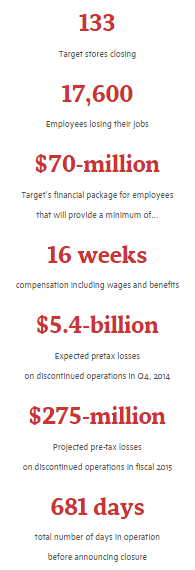
A 107,000 square foot stand-alone store, Polo Park Shopping Center in Brandon, Manitoba is the quintessential of Target Canada’s failure, closing just three months after its opening day ceremonies. (CBC)
At the end of Samantha’s post regarding the retail market, she poses an open ended question that speculates the reasons for Target’s incapability of competing in Canada and translating its prior success into an exceedingly similar market. Although she never elaborates on this question, she efficaciously answers her own question by mentioning the alleged similarity between the value propositions and strategies of both Walmart and Target.
When Target Corporation executed a deal that consisted of the purchasing of 189 leaseholds of Zellers across Canada in 2011, Canadian consumers were equally as vehement as they were exhilarated. The notion that the highly acclaimed retailer was expanding to Canada subsequently created lofty expectations that Target, priming it for ineluctable failure. From the beginning of its tenure, Target’s upper management treated the fledgling endeavor in a separate manner to that of its American incumbent. This treatment most likely occurred due to the entrenched American corporate mindset of the lackluster Canadian market, composed of the supposition that the Canadian marketplace is essentially a “minefield.” Analysis of the retailer’s flirtation with the Canadian economy via different methodologies displays the astonishing amount of blunders that now-defunct Target Canada made.
Shortly after Target Canada conducted its grand openings at each of its respective stores, it became increasingly clear that the previously Zellers branded stores were downtrodden and disheveled, incapable of meeting both Target’s and its consumer’s needs. Furthermore, the location of these stores was an anathema; its major customer segment, the middle class, could not justify the elongated commute to many of these destinations. Consumers immediately took notice and scoffed at its seemingly different appearance from its American counterpart. A departure from its box-like layout, Target immediately tarnished its image, changing its perception and inadvertently shifting its position in the Canadian consumer mind for the worse.

An info graphic created by the Globe and Mail depicts Target Canada’s statistics at the height of its ignominious debacle. (Globe and Mail)
In response to Target’s arrival, Walmart Canada immediately took hostile action, engaging in a relentless price war with Target and intensifying rivalry in the superstore industry. Through the lens of a Porter’s five forces, it was evident that buyers received a new-found increase in power, with a growing amount of options to expend their dollar. In response to Walmart’s course of action, Target was handcuffed and could only undertake two options. With the first option, Target attempted to price match, which attributed to its gargantuan losses of $2 billion USD. When the first option became infeasible, Target attempted to sell its products at the previously higher price point, imploding its own key value proposition and thereby alienating its entire consumer segment.

Amidst a fiasco, empty shelves further beleaguered Target Canada’s ability to meet waning consumer demand. (Business Insider)
The final nail in the coffin for Target Canada’s during its tenure was its inability to consistently maintain inventory that would satiate its consumer’s needs and demands. Whether this abomination was a result of poor vertical supply chain management or Target’s ambition to create a cost leadership strategy by having minimal inventory remains a mystery up to this day. Overall, the overarching issue that plagued Target Canada’s existence and potential were the immeasurably horrific decisions made by upper management. Although Target Corporation was able to exit the Canadian market with relative ease aside from the $2 billion debt that it accrued, the firm’s tumultuous performance may detract potential shareholders from the company, hindering future growth and ultimately livelihood in the fickle precarious retail space.